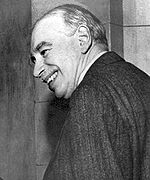Keynes on the Fed
 Boy, An Economist's Biography is the gift that keeps on giving. In 1931, Keynes visited the U.S., and met with a number of influential people (Hoover, Fed governors, etc.) to discuss the economy.
Boy, An Economist's Biography is the gift that keeps on giving. In 1931, Keynes visited the U.S., and met with a number of influential people (Hoover, Fed governors, etc.) to discuss the economy. He thought that the Federal Reserve might pursue an expansionist policy, but it might not carry it far enough. He did not expect "magical results". The reasons for his pessimism lay in the state of the American banking system [. . .] At the heart of the banking problem was the banks' balance sheets. Keynes estimated that at least 10 per cent of the banking system (measured by assets) was already insolvent [and that there was] the prospect of "more skeletons in their cupboards than anyone yet knows for certain" [referring to the large NYC banks].This sounds familiar, eh? Substitute "financial institutions" for "banks," and it describes the situation today.
But not really. The "skeletons" Keynes is talking about are reserves. His feeling was that the big banks and the average American saver were hoarding money, leading to a liquidity crisis that no reduction in rates could fix. Regional banks, which provided capital loans to business, were the ones being squeezed into insolvency. Obviously the problems today are that non-commercial banks carried too little in reserves (not being bound by the Basel Accords), and that no one trusts the values of the assets on financial institutions balance sheets, especially if those assets include CDOs and CMOs. Still, funny how apt his statement is. There are a lot of skeletons in banks' cupboards today, even if they are rather different than those of 1931.
Labels: economics

0 Comments:
Post a Comment
Subscribe to Post Comments [Atom]
<< Home